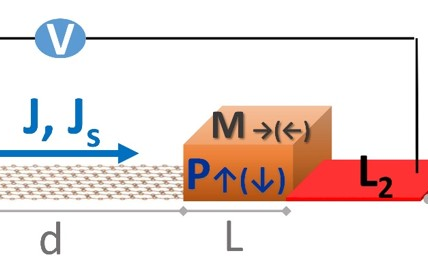A possibility of controlling electronic and magnetic properties of graphene via proximity of multiferroic substrate is demonstrated. Coupling graphene to a multiferroic oxide (bismuth ferrite) give rise to novel class of spin-dependent transport phenomena based on multiferroic-induced proximity effects in graphene. Based on these findings, a concept of multi-resistive device in lateral geometry is proposed.
Graphene spintronics has become a promising direction of innovation that attracts a growing attention of scientists and engineers. Numerous efforts have been devoted to inducing magnetism in graphene via different means, one of which is the exchange-proximity interaction with magnetic insulators. Both experimental and theoretical developments on tailoring the proximity induced magnetic phenomena in graphene have been focused so far on using different magnetic insulators. Multiferroics co-exhibiting a magnetic (M) and ferroelectric (P) order constitute an interesting class of magnetic insulators that bring about an additional parameter in play that is the electric polarization P. However, the influence of both M and P orders on the proximity effect in graphene remained unaddressed.
Using first-principles calculations, Spintec theory group in collaboration with colleagues in France and USA have reported multiferroic-induced proximity effects in graphene that can be used to propse a six-resistance device. The calculations clearly show that by contacting graphene with bismuth ferrite BiFeO3 (BFO) film, the magnetic order and the ferroelectric polarization in the BFO substrate strongly affect spin-dependent electronic structure of graphene. Based on the extracted Hamiltonian parameters obtained from the graphene band structure, the group employed the tight-binding approach in the framework of scattering matrix formalism to calculate conductance and proximity resistance effects in a lateral device comprising two multiferroic regions on top of a graphene sheet. Exploring dependence of conductance on all possible relative magnetic and ferroelectric configurations of two BFO regions, six distinct resistance states were unveiled leading to a concept of multi-resistive lateral device. Furthermore, conductance states in the system give rise to three types of proximity resistance effects: proximity electroresistance (PER), proximity magnetoresistance (PMR), and proximity multiferroic resistance (PMER).
This finding paves a way towards multiferroic control of magnetic properties in two-dimensional materials and engineering of graphene spin gating by proximity effects.
Team: Theory and simulation
Collaboration: Univ. Grenoble Alpes, CEA, IRIG-PHELIQS, Grenoble (France); Dept. of Physics and Astronomy & Nebraska Cent for Materials and Nanoscience, Univ. of Nebraska, Lincoln, NE (USA)
Funding: European Union’s Horizon 2020 research and innovation program: Grant agreements No. 696656 & 785219 (Graphene Flagship). French ANR Project FEOrgSPIN (ANR-18-CE24-0017)
Further reading: Unveiling Multiferroic Proximity Effect in Graphene, F. Ibrahim, A. Hallal, D. Solis, X. Waintal, E. Y. Tsymbal, M. Chshiev, 2D Mater. 7, 015020 (2020). DOI: 10.1088/2053-1583/ab5319
Contact: Mair CHSHIEV (mair.chshiev@cea.fr)
Figure: Lateral spintronic device comprising two multiferroic regions on top of a graphene sheet. The relative orientation of magnetization M and electric polarization P in the multiferroic regions, give rise to proximity electro (PER)-, magneto- (PMR), and multiferroic (PMER) resistances.

